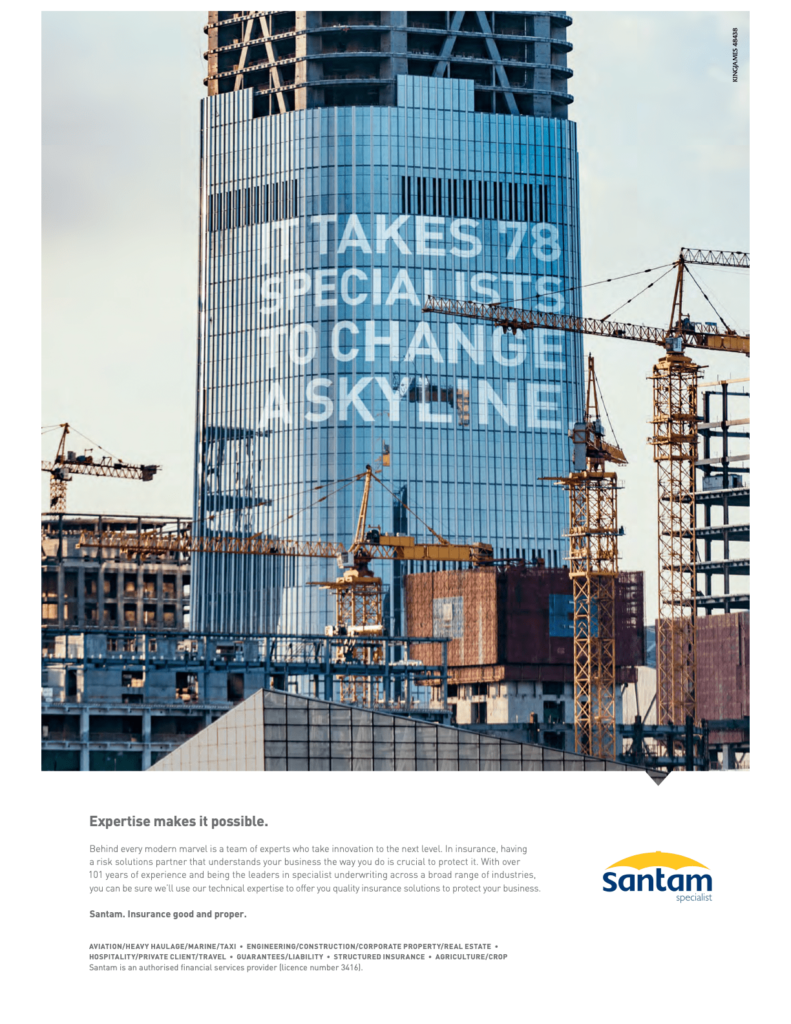By John Melville, Chief Underwriting Officer at Santam
Since insurance first started centuries ago, premiums have been determined on the basis of client risk profiles, with insurers pooling risk across large numbers of clients to take advantage of the laws of large numbers. It has always been imperative for insurers to ensure that their premiums reflect client’s individual risk profiles because otherwise their risk pool would attract higher risk clients and repel lower risk clients. When it comes to property insurance (e.g., buildings and contents), companies such as Santam embrace technology to ensure that premiums are fairer and better differentiated between clients. Geolocation or geocoding technology allows insurers to more accurately weigh the risk of a property based on its location. With this information, insurers can generate more accurately priced policies.

The World Bank’s Climate Change Knowledge Portal states that fires, floods (caused mainly by storms) and drought have recently given rise to significant social and economic losses in South Africa. This year alone, the severe flooding and landslides caused by heavy rainfall in April resulted in 448 deaths, the displacement of over 40 000 people and the destruction of over 12 000 homes in KwaZulu-Natal.
Fires have also caused major damage over the last few years and seem to have increased in frequency and intensity, from the devastation caused by the fires in Knysna in 2017 to the devastating fire on the slopes of Table Mountain above the University of Cape Town in early 2021.
These natural disasters are expected to increase because of climate change. In fact, fire, flood and drought have been identified as the three primary natural hazards facing South Africa, impacting our economy and having a major effect on the insurance industry. This has been compounded by the devastation caused by the COVID-19 pandemic.
While natural disasters and even pandemics are not under our control, using technology to assess risk is revolutionising insurance.
Geolocation as a risk mitigation tool for insurers
Increasingly, insurers are implementing location-based underwriting to identify the geographic, location-specific risk profiles of the properties that they are insuring. In fact, this is fast becoming an essential requirement for all types of insurance.
Similarly, insurers having to deal with declining municipal infrastructure risk can attempt to mitigate their exposures by collecting an array of related geolocation-based information about the areas that they insure.
Properties that are in low-risk locations will continue to be insurable on normal terms, while those in higher risk areas may become increasingly difficult to insure, or lead to higher excesses, higher insurance premiums, and/or additional expenses to meet special risk mitigation requirements imposed by insurers.
Geolocation technologies also have other benefits. During the height of the COVID-19 pandemic, Santam secured an agreement with the National Institute of Communicable Diseases (NICD) to use some of its data to better understand the spread of the pandemic. This simplified the requirement for clients to provide proof of the occurrence of the pandemic within a certain radius of their premises, and enabled the fast tracking of business interruption claims, saving clients time and effort.
Global impact and losses
With the increasing prevalence of disasters affecting many countries around the world, so too is the prevalence of higher economic losses. When it comes to insurance, the sad reality is that only a small fraction of these losses is insured, with the so-called ‘risk protection gap’ falling on individuals, communities, and Governments.
The new EU Adaptation Strategy highlights that affordability and insurability of natural catastrophes is likely to become an increasing concern. In fact, research shows that in the past, only a quarter of the total losses caused by extreme weather and climate-related events across Europe were insured. This strategy also outlines the need for improved climate projections. Unless measures are taken, the rise of these types of climate-related disasters will further widen the related protection gap.

Expertise makes it possible
Behind every modern marvel is a team of experts who take innovation to the next level. In insurance, having
a risk solutions partner that understands your business the way you do is crucial to protect it.
Santam is an authorised financial services provider (licence number 3416).
It will be important for Governments and Insurance and Reinsurance companies to work together to protect vulnerable individuals and businesses who are unable to access affordable insurance in the future. There are many examples of public-private partnerships around the world that facilitate access to subsidised insurance e.g. FEMA, the National Flood Insurance programme in the USA, Flood Re in the United Kingdom, and the African Risk Capacity (ARC) Group in Africa.
The need for resilient environments
Another important driver of human and economic losses arising from these hazards relates to the resilience of the environments where people live and work.
This includes the quality of public infrastructure and laws, ranging from stormwater drainage, land-use and urban planning controls, fire-fighting capabilities, and environmental management in general. Environmental management considers factors such as foredune management to prevent ocean flooding, riverbank vegetation and estuarine management and the removal of exotics that burn at high temperatures.
Impact on insurance
The insurance industry has been impacted significantly by the increase in these hazards. Santam’s flood and storm damage claims from the KZN floods reached over R4bn this year alone.
Key impacts include:
- Increasing (re)insurance premiums: Globally, reinsurers are cutting back on the capacity that they make available for catastrophe reinsurance, with the pricing for the capacity that they do provide increasing. This inevitably must be passed on to buyers of property insurance.
- Insurance may become unavailable in some instances or more restrictive in others, with insurers making greater use of location-based geo-analytical tools to assess the local flood, fire, and other risks. These analytics will be used to exclude certain types of cover in high-risk areas or impose high excesses in certain locations.
Preparation is key
By anticipating, preparing and recovering, the insurance industry can better manage the impact of these severe weather hazards.
Essentially, insurers such as Santam aim to provide clients with cover on a sustainable and appropriate basis, which requires that sufficient premiums are collected to pay claims.
Expert risk assessments of properties that are particularly exposed to perils such as floods and fires are vital. Based on these, an insurer may require its clients to take action to improve the protection or resilience of their properties in the event of a catastrophe.
A catalyst for economic recovery
Insurance is a powerful catalyst for economic recovery after a natural disaster and this has powerful implications for economies around the world. Economies that are uninsurable can suffer permanent damage after natural disasters and can end up in long-term economic stagnation because of it.
Society has a powerful interest to work together to ensure physical resilience so that the mechanism of insurance can be put to work. It has also been shown that insurance-led recoveries tend to be far quicker and more efficient than Government-led initiatives to recover from a disaster.
Insurers using geolocation tools to re-evaluate risk and pricing models is changing the face of insurance. Location technology is not only valuable when accessing and managing risks, but also has an enormous role to play in managing insurance claims and even in detecting and minimising insurance fraud. This really is the future of insurance, and Santam is proud to be spearheading this in South Africa.
To earn CPD, click on the February 2023 edition link below: https://www.learnon.co.za/course/index.php?categoryid=112


